#Water Irrigation Filters
Explore tagged Tumblr posts
Text
Water irrigation filters are an essential part of any irrigation system in the UAE. The desert climate means that water is often contaminated with sand, dirt, and other debris. This debris can clog irrigation lines and nozzles, leading to reduced water flow and efficiency. Water irrigation filters can help to remove this debris, ensuring that your irrigation system is running at its best.
#Water Irrigation Filters in UAE#Water Irrigation FilterS#scigt abu dhabi#https://scigt.ae/#silver coast irrigation solutions#https://scigt.ae/contact/
0 notes
Text
Top Water Filter Manufacturers for Organic Farming in Gujarat - Manan Water Tech
Discover Manan Water Tech, leading water filter manufacturers in Gujarat, providing advanced filtration solutions tailored for organic farming. Ensure sustainable and efficient farming practices with high-quality water purification systems. Learn more about our eco-friendly water filters and how they benefit organic farming.
0 notes
Text
Irrigation Filter from DFShouTech
Keep Your Irrigation Systems Running Smoothly!
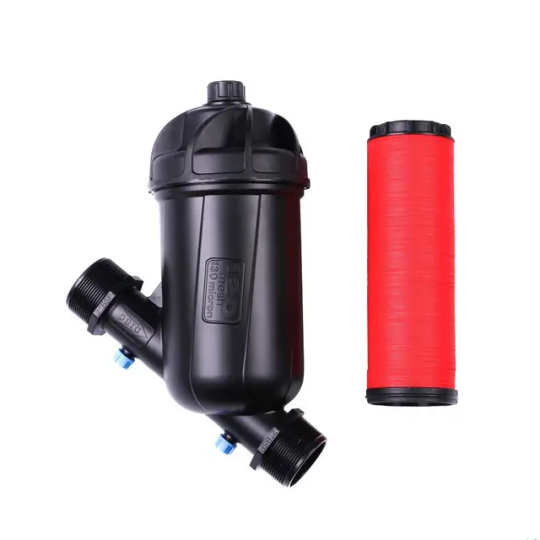

Keep your irrigation systems running smoothly with the DFShou irrigation filter! Say goodbye to clogged sprinklers and hello to efficient watering.
Our innovative filter ensures clean water flow, preventing debris and sediment from causing any damage.
Say yes to hassle-free gardening and enjoy a lush, vibrant garden all season long!
0 notes
Text
To make a pond + Earthworks!
I've been enamored by the idea that I could build my own pond in the future, but when I started looking into it (typing 'how to build a pond into youtube'), all people did was put a big plastic tarp into a landscape and add water inside. That wasn't what I wanted. I wasn't about to bring a plastic tarp in my environment, and it was obvious that once the tarp gets damaged and punctured, the water would drain into the soil and the pond would be no more. That's no fun.
Unable to immediately find a better way, I turned to my own brain to figure this out. There were natural ponds in the world, and somehow they didn't need a tarp to hold all that water in. Artificial lakes existed, and for sure there weren't any tarps holding the water in. Rivers don't drain easily, and they usually have a lot of sand on the bottom – but sand is a very drainable material, so that's probably not it.
I stumbled upon an interesting piece of information when I was learning about rocks. By some definitions, ice is also a type of rock, so there was a lesson on icebergs. I found out there that sometimes icebergs split apart and travel in the water, and when a huge chonk ends up in a non-icy landscape, it eventually melts and it turns into a lake. There were pictures of lakes that looked like they had no business being in that landscape, but were there because an iceberg had melted there. The water didn't drain or ran off, why? I assumed it was because the iceberg was so heavy it compacted the soil underneath, and the compacted clay was enough to hold the water in.
So I started playing with the idea that if I locate a soil with high percentage of clay, and then dig a pond, and then line the bottom with the highest-density clay I can find, and then I redirect all water from the landscape to go towards that pond, maybe I could make a little pond in there. Possibly it would dry out during the summer but for the rest of year, having a natural pond would be very nice. I wasn't sure if this logic would hold but then I also couldn't see why not. Clay doesn't drain easily and there's lots of it deep underground. I would grab a shovel and try.
I got an additional piece of information reading a book about collecting and filtering rainwater to make it drinkable; the book recommended before you do anything about this, you need to learn about 'Earthworks', a system of modifying the earth's surface to keep as much water in as possible, and to redirect it to where you want it. I immediately liked this, because I had already planned to do that, but I was interested in tried and true methods. So I looked it up, and one of the first videos I've found, was of people deciding to make a natural pond in the forest. They found the most dense clay-rich ground, dug to see if it was super dense and non-draining deep in. Then they created a dam to stop water from flowing past the pond, and redirected all rainwater that would fall into the forest, towards the pond. And it worked. It filled out within a month or two. It wasn't draining away.
I felt so vindicated, the logic I had put together in my head was real and I could see how other people did it in real life! And I learned about berms and swales; they're methods of making your ground uneven, so it could take in and hold more rainwater. Berms are little hills you make that have good drainage, and swales are shallow canals you make inbetween the hills; they hold the rainwater, stop it from flowing away from your property, and redirect it to where you want it to, for instance to irrigate a garden, fill a pond, or to water a big tree you want to grow.
The methods of keeping rainwater from evaporating are currently relevant, because the climate is getting unstable, and rain is no longer as consistent as it has been in the past. I've noticed that we now get tons of rain in the spring, winter and fall, but next to none in the summer, creating a drought. The forests and the animals feel it too; they struggle to survive the summer, and a lot of plants and animals die from lack of hydration, which they didn't need to deal with beforehand. There's also less ground covered by old resilient trees and foliage that keeps the water in the landscape; clean cutting forests means dry ground, water evaporating, streams and canals drying up, trees drying up because of no water supply.
The people who were building a pond in the forest were not doing it for fun and giggles; they noticed the natural streams of the forests have dried up as a result of cut areas and lack of consistent rain. The forest was in danger of drying up. So by building a system of swales (or trenches) to redirect rainwater, and ponds to store it, they've managed to revitalize parts of the forest. The forest around the pond was visibly greener within months, wildlife was multiplying around the pond where it could get water, new flowers and native plants were flourishing next to the pond.
Slightly modifying the landscape to keep water in is something people do to prevent the spread of deserts; digging half-moon shaped holes in the ground to hold water has enabled trees to grow even in the driest, sun-heated areas. I've been fascinated by the methods of growing trees in the desert! And right now we need to make sure other livable green areas don't start turning into deserts, because the climate is threatening it, and the animals are unlikely to survive it all on their own.
And if you build a little pond, you're gonna have more birds in your backyard. There's gonna be little frogs and turtles and tiny critters coming to drink from your pond. Maybe a little lizard or a snake. You're gonna be able to plant flowers around it, your trees will be happy, and if you want a great big willow, she's going to enjoy that water too, and purify it with her roots. I'm still putting it together in my brain if I could make a little swampy area and plant rice in it, that would be the ultimate success.
#earthworks#permaculture#pond#diy pond making#clay pond#environmental#learning about nature#rainwater#collecting rainwater#rain#preserving rain#making livable landscapes in the time of climate change
42 notes
·
View notes
Note
When thinking of fantasy world building nonsense I only now realize the absolute hell getting pure water would be. 100% pure water, not well or river or mountain water with its load of impurities. If a modern first-world human drank from any of these there would be a good chance they would just die. Sure if you make holy magic “return to state” then you can get much more 100% pure water but that leaves us with infrastructure inequity where it would be hard to supply border towns.
And we don’t just use water to drink, we use it for paper, and irrigation. Why the fuck all these Isekai pro tags inventing guns and shit make a water filter and the death rates drops by what 20%?
It depends on the quality of the water supply.
And the medieval answer was just to make everything weakly alcoholic.
9 notes
·
View notes
Text
The Seeds We Sow
The fic + art collaboration Art completed by @mirandemia for the @ahsokaevents Wildflowers collab! Find it on AO3!
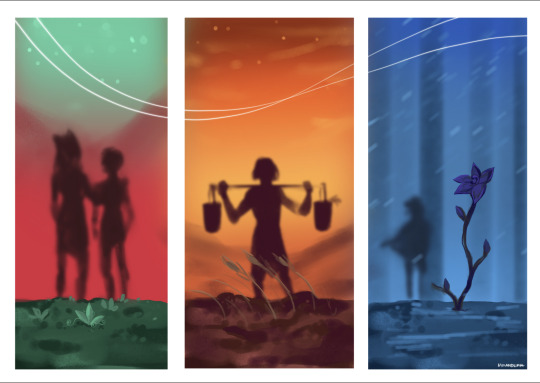
Sabine Wren + Ahsoka Tano The soil was warm under her hands; Freshly turned and clumpy where she uncovered it from the ashen tones of the earth. “Life finds a way.” Ahsoka had told her upon setting out on this task. The water source wasn’t too far away, a still pool with sediment floating in the murky water.
“We can get this cleaned up, can’t we Asha?” She called to the howler, snuffling through a patch of stubbornly prevailing grass nearby. She did not receive any response from the peculiar creature, though it was nice to have her to bounce ideas off of.
The Noti had given her the scraps from an older trawler, dragged each time they moved to limit waste, carrying broken vaporators, gears, and even old power packs to blasters that must have been acquired from Thrawn’s troopers. At least she didn’t need to lug it too much further than their current campsite to get it near the water supply. “Let’s see what we can do,” The Mandalorian talked aloud, boots crunching over the crumbling outer layer of the planet’s crust.
First, Sabine grabbed old pipes from blown cooling systems, using her hands to dig out four long rows in the dirt, exposing nutrient-rich soil to the sunlight above. “Bet you guys missed the sun just as much as I do,” She chuckled warmly to a squirming lifeform. “You kinda look like an exogorth. Can I call you Exo?” The pad of her thumb brushed along the sliminess of the creature's side, laughing warmly to herself when it squiggled away. “Alright, Exo. I’m sorry I gotta move you, but hey, you keep pests away from my seeds, and this can be a mutually beneficial arrangement, got it?”
The creature was set inside of a pile of upturned dirt, where it happily burrowed itself to be rid of the humanoid that dared interrupt its rest.
Building the irrigation system was nothing new to Sabine Wren; In fact, it was something she understood almost as well as mixing her explosive paints. Back when rebel holdouts needed crops, she was often the one counted on to help them get started, and it was always something that helped her feel useful.
A Mandalorian could destroy, and conquer, and a million other destructive things, but she was put in this Galaxy for more than that. She created, and saved, she strived every day for as long as she could remember to embrace her Mandalorian heritage, to be everything her ancestors could have wanted, and then some.
It was through her continued work every day that she honored the patron of her House, Tarre Vizsla, it was through her dedication to her people that honored her Clan and the lives they’d once lived, and it was her determination that honored the Rebellion she’d spent so long fighting for. Everything she did was for her family, and right now? That family was found in Ahsoka and the Noti.
Her purification system was simple in design, and it required the sacrifice of a power pack from her blaster to generate enough of a spark to keep the miniature solar array working. She could return with a new source for it one day, for when the sun grew dim and the gears needed to turn. For now, the blaster she’d painted in the blues of reliability and royalty was dismantled under a caring hand and slotted into the home of the system.
Clean water trickled slowly with a quiet whir of machinery, sucking the water through and filtering out sediment as it pushed along the rows of water she’d dug out. “Hey, we did it,” She called to Asha, now dozing lazily in her interesting patch of grass. “Thanks,” She laughed, bubbling like the carbonation in The Outlander Club’s specialty beverage, warmed by the lull of a punk tongue hanging lazily past yellowed canines.
With dampened soil, Sabine was able to meticulously lay each seed; They were from her Galaxy, so there was no telling if they would take to their new home, but she had hope, and she’d learned long ago just how far a little hope could stretch. Then, the compost that had been saved up was spread evenly over the rows, pressed in lightly to allow for the sprouts to push past without much resistance, though would not risk being washed away when the drought on this side of the planet would end at last.
“You’ve done well,” Ahsoka’s voice was warm; Lighter than she was used to, over the course of her previous apprenticeship, that is.
“Yeah? You think so?” The Mandalorian questioned genuinely from her spot knelt in the dirt, mud caked her armor and her flight suit, and streaks painted her face and dirtied her hair. The purple-haired woman turned her head to watch as Ahsoka dismounted her howler, allowing it to trundle to Asha’s lazy form. “I do,” The hand on her shoulder was warm. Sabine allowed the offered strength to rise from her knelt position. “Lunch is ready back at camp, you look like you could use it,” The jab was light, bouncing off her armor with a light chuckle.
“You’re tellin’ me… Think everything will be safe here?”
Ahsoka’s gaze turned to the horizon, searching. When she shook her head in the affirmative, Sabine’s shoulders relaxed. “Do you think they’re okay…” She questioned after a moment.
It didn’t take a genius to understand who she was asking after. “Shin will be alright, I’m sure of it. Baylan… worries me, he’s treading a dangerous path, one we will have to follow, sooner than later.”
As the Master and Apprentice rode their howlers the short distance back to camp, Sabine’s fingers threaded through the thick, dark wool of Asha’s neck. “Thanks,”
Ahsoka’s head bowed towards her. She could have kept the thoughts to herself, as she’d once had. But even Ahsoka Tano learned when it was time to truly be more than the people who’d trained you. Where Obi-Wan and Anakin may have kept themselves quiet, she was determined to break the cycle. Shin Hati
Communication with the bandits was slow. Truly, Shin had heard of droids learning and adapting better than this sorry lot. All she received from them were grunts, either of indignation, or approval, she could only tell after they’d begun moving, either to follow her orders or to blatantly ignore them.
The most recent act of ignorance from the clan found Shin stubbornly figuring out ways to feed them all. They’d seemed unbothered by the prospect that they could go hungry, as if they could pillage their way across Peridea; and maybe they could have, if not for the Jedi and Sabine protecting their favorite victims now. Shin knew better than to allow themselves to march into that camp, she knew what the Torguta and Mandalorian were capable of.
Chasing away the nomads that had settled in this desolate canyon had been simple, natural, even. The moment they saw a blood-orange blade on the horizon, and saw the sun glinting off the worn paint of her bandit’s heads, most were intelligent enough to turn tail. It had even stocked them up with enough supplies to last until… well… Until what, Shin wasn’t sure yet, but they’d be damned if they didn’t figure it out soon.
There was a water source nearby, old, rickety purifiers ran as they refilled the jugs as fast as her men could deplete them. They also noticed a raised bed of soil, something she didn’t see often in the wastes like this. There were no seeds nearby, though she could see plants sprouting from a host nearby.
Eyes as dreary as their landscape peered around the supplies that had been left. This was new, but they had always been a resourceful student. If taking lives was so natural, then surely they would be able to sustain it, especially in the most non-sentient way life existed.
The soil had been freshly turned, Shin learned as their fingers delved into the raised garden bed. The travelers had been planning on making this place their home for the season as well. No matter, it was Shin’s people who were victorious in the end, and they would reap the profits of prior labors… and Shin’s own.
Dirt spilled into the many tears in their gloves, worn from the months of use and with no true materials to repair them. The pebbles were harsh, though their skin was learning to grow harsher. Eventually, the tanned gorraslug material was set aside, resting precariously on a wooden support, allowing them to dig deeper, pushing grime up under their fingernails as they worked to bury the remains of the food supply.
Plasto pails sat near the purifiers, and it was just Shin’s luck that the first pail they filled with water would crack under the unforgiving weight as it was filled to the brim. “Karabast!” They growled at the remains of the bucket, water soaking their boots and turning the ground at their feet into sloshing mud.
The Force, a fickle ally, refused to answer their call in their growing frustrations; Even as they attempted to channel their annoyance into the pressure of water, thin plasto, and the space they wanted to create between it and the ground.
Huffing and puffing, Shin found themselves resorting to other means; A spear was sent between the weak metal handles of the pail, allowing her the leverage to lift it, keeping it balanced on her shoulder with minimal spillage as she lugged it to the beds, cursing the whole way.
By the time each sprout had a home in the dirt, Shin’s hands, tunic, and face were streaked with mud, sweat cutting tracks through the grime as they sat back against a boulder to admire their work. A bandit passed by them, Shin watched with narrowed eyes as they paused at her work.
No words were spoken between them as they turned back to look at the filthy blonde, though Shin had felt the understanding in the nod of their head. A dented canteen was removed from their hip and passed nonchalantly to her on their way back to sorting through their treasures of the raid.
The sinking of the sun was met with a wet nose sniffling at long-dry boots, a dirty white howler in search of food. With her fingers carding through the soft fur at its neck, Shin rose at last, acquiescent to find the poor beast something to eat, and with a rumbling of her own stomach, something for herself as well.
Ezra Bridger Krownest had always been cold, but if there was anything Ezra Bridger had learned in his short experiences with Clan Wren, it was the planet's unique ability to nurture all kinds of life.
This was why, as the Ghost touched down on a desolate surface, and no gruff voices came over their comms to demand clearance, Ezra felt the loss of those unique lives as distinctly as he had. The Jedi paused in the entryway, boot hovering just over the ramp. “Ezra?” Hera called, a gloved hand coming to rest on his shoulder.
A deep breath and a warm smile recentered him as he used the familiar touch on his shoulder to ground himself. “I’m alright… It’s just hard not to notice…”
Hera’s head dipped in understanding; She hadn’t made the venture yet, had been waiting on Sabine’s word to visit with the heir, the day had never come, until Ezra voiced his desire to do something for her family. “We’ll be right here with you,” She promised, glancing away from Ezra to peek down at Jacen, bundled up and standing by her side, with Chopper rolling just behind them once they began walking.
The Wren stronghold was dark and untouched, mountains of snow coated the roof, while dangerous icicles hung dangerously along the large transparisteel windows. “Do you think it’ll grow here?” Jacen asked as the toe of his boot caught on a patch of slippery ice. .
“Yeah, ‘course,” Ezra mused out loud as he knelt near one of the windows. Peering through the dust, he could see the inside of the throne room, dark and desolate, with cobwebs hanging across each surface. The light that managed to cut through the grime still found a way to cast across the painting of the Matriarch of Clan Wren, lighting yellow and grey armor up in an effect that made them glow gold and silver.
“Do you remember how it went?” Ezra questioned, unblinking from his sight against the glass, catching the barest reflection of his own eyes back at him.
“Never did manage Mando’a,” Hera admitted, lowering herself into the snow beside him, allowing Jacen to tuck himself against her once more as she settled. He’d known Ursa, though Hera doubted he would have much memories of them, not with the separate wars they found themselves fighting as Sabine focused on finding Ezra.
“Basic should be fine… It’s the memory that counts, right?” He tried to keep his tone light, tried to keep the calmness steady, though the emptiness seemed to echo the way his words caught around the tightness in his throat. Addam’s apple bobbing, he nodded his head towards the snow, beginning the process of clearing away the piles to the frozen earth underneath.
They did not have every name of every warrior lost, and Ezra found himself regretting this, too naive and headstrong, too worried about the fight than the lives of the people he’d fought beside. He would return, when the seasons changed, when Sabine came out. She could tell them their names, and they would plant flowers for them as well, as a family again.
The ground was frozen and solid, though after a while of digging and chipping away, he’d been successful in clearing three small holes. “Vormur can grow through anything,” He assured himself as he retrieved a small duracrete container, filled to the brim with dirt from Lothal, soft enough to cover the tops and hopefully prevent them from freezing over. “They’re Mandalorian, you know” A foreboding gaze was sent to the portain through the windows before he dropped a seed in each hole. Hera stayed silent, for him, for Sabine and Ahsoka, and for Clan Wren itself.
“Jace, you wanna cover this up, for aunt ‘bine?” He offered, leaning back as he cleared his throat, hiding a sniffle as he wiped the rough nylon material of his sleeve under his nose. Small knees shuffled through the dirt as the boy inched closer, mittens sweeping through the uncovered dirt to start brushing it to the small array of flowers. “These smell really nice,” He commented as he worked, taking a big sniff as the dirt began to settle. “Aunt Sabine will really like this when she comes back-” The young Force-Sensitive boy paused then, fingers curling in his mittens as his brows drew together. “If she ever comes back…. Here, i mean.” He was quick to correct; No one aired their thoughts about the possibility of Sabine and Ahsoka’s return, not when Ezra himself had been gone so long.
“Well, when she hears about all our hard work… I’m sure she will,” Hera’s hand brushed over Jacen’s head, pulling the wool hat on his head askew. Final preparations were made to keep the flowers healthy and strong from the climate. Just as the sun began to crest the mountains, pink and golden light splashing across the grey landscape of the frozen lake. Before they could leave, the Rebels settled back in one last time, peering through dust covered windows at the haunting silhouette of the Countess of Krownest one last time. “Ni su'cuyi, gar kyr'adyc, ni partayli, gar darasuum, Clan Wren.” Their Mando’a was rough and heavily accented, but the words seemed to release some of the weight on their shoulders, allowing them to return to their new war with a lighter conscience.
#cc24wildflowers#Pathfinders#star wars#shin hati#sabine wren#ahsoka#ahsoka series#ezra bridger#Clan Wren#Hera Syndulla#Jacen Syndulla#star wars rebels#fanfiction
43 notes
·
View notes
Text
Life needs water.
The Under, luckily for its unwilling inhabitants, has water.
To be more honest, water is unavoidable in the Under, as it has shaped a vast portion of its twisted architecture. Underground rivers and the slow dripping of water through the cracks are a factor, yes, as usual in cave formation - but not only them. They say unimaginable volumes of water once tore through the Under, washed through the earth with furious waves and connected the chambers of the Purgatory. They say that was the Fall.
Fall waters are remnants of that ancient fury, pockets of saltwater in the dead ends of the tunnels, crevices and wells. Dead, still lakes, slowly seeping through the rock deeper and deeper. Full of rusty secrets and disintegrating bones.
Calling them "dead" is somewhat misleading though. Even though enough time has passed for the corpses to rot away and even for the scavengers to die off, foamy layers of bacteria often feed on the minerals within. Sometimes tendrils of the Flesh breathe new life into these ponds, and tiny crustaceans scuttle among the crushed gravel.
Natural rivers and streams flow through the caves as well, and when they connect to the fall waters, the drowned secrets are once again drawn by the currents. It is not uncommon for pressure to accumulate slowly and for water to erupt into another chamber either. That is to say - water is unpredictable in the Under. It is a force worthy of respect and extreme caution. Besides concealing environmental dangers, it is never certain to be safe to drink, as reservoirs, isolated for years, might suddenly mix through an unseen faraway hollow.
The ancients had the technology to filter this water. In the upper reaches of the Under, water stations pump or collect water into reservoirs. Those filters are now almost impossible to reproduce, but they are plenty, even if some of them get clogged, malfunctioning or severed from their cables. There is plenty more in the Fallen Heaven itself, should someone be desperate enough to return there.
Deeper in the Under though, one will have to rely on the natural waters. On their own judgement, their own portable filters, and the moisture from living things. They say there is a sea down there, somewhere - a place where all the fall water eventually goes to, and where the two main known rivers flow.
Lete and Akeron (no, no one remember why they are called that) mark the boundaries of human habitat, in a way. Far from the usual image of a river, these are ephemeral and ever-shifting, burrowing into walls and carving through the underworld, emerging as a trickle in one place and a violent flood in another. Lete is used to irrigate the automatic Farms, though the widespread presence of Raptors makes it difficult to utilize fully. Its flow can be heard even through the walls, and thus a helpful "landmark" of sorts. Akeron flows from "the Dam", which most in the Under know well to avoid. Slower and prone to droughts, it is both less dangerous and less reliable. The City of Fire used to rely on the water from Akeron, and it reaches all the way down to the Intestines. Many areas of open Akeron have life in them - especially where it flows over areas volcanic activity, creating a sort of "river geothermal vent" environment.
#secrets of the under#if you have any questions about the lore of my worlds - my asks are open :)#it'd be a pleasure :)#worldbuilding lore#worldbuilding setting#worldbuilding#lore
10 notes
·
View notes
Note
What are your opinions on fertilizer runoff from industrial farming? Its ingredients such as phosphate and nitrogen can facilitate algae blooms, which in turn can cause artificial eutrophication, and or release toxins like microcystins.
My opinions are mixed! Also, this is a long post, so I've put the rest under a keep reading. Please do read! I just don't want to fill people's dashes with a long post every time they scroll lol.
Firstly, I need to say that if we were to broadly ban or heavily restrict fertiliser usage in agriculture, it is undeniable that the agriculture economy would collapse. Most industrialised farming is incentivised to sell the 'ideal products' to consumers, which inevitable means a shitload of food production in order to get the highest amounts of 'perfect' product. This requires a lot of fertiliser usage in order to mass produce and harvest monoculture farmland, and also results in a LOT of food waste. Unfortunately, the agricultural economy, combined with the half century of brainwashing by advertising companies telling people that so called 'blemished' food is somehow bad for you, is so based on this excess that if we did immediate drastic action, it would implode and likely send the prospective country into a recession.
With that being said, the system of heavy use of fertiliser is still not good!! Fertiliser runoff causes eutrophication as you point out, and can lead to toxic algal blooms, or even oxygen dead zones further down stream. However, it is not solely the use of fertiliser products that contribute to fertiliser run-off, as contradictory as that sounds. In fact, soil quality has a large part to play in the production of run-off.
For example, most modern agriculture uses monoculture, which is when one plant species is grown in the same place with little to no diversity in the field. A result of this is that only a single type of root system is grown, which is not enough for a healthy layer of topsoil to develop, especially if it is tilled and plowed every season. This means that the soil is very poor at retaining water, meaning that it requires LOTS of irrigation. With lots of irrigation, the fertiliser nutrients can't stay in the soil long enough to be absorbed by the plants fully, and they get washed away and have to be constantly topped up.
If we used less monoculture in our farming, we could use less fertiliser and still gain the same benefit, with also less runoff, which would be ideal!
I would also note a few things, namely that fertiliser runoff is not the only source of nutrient pollution from farming, and especially in places that have heavy cattle farming like my country, nitrates and phosphates from stock effluent is more of a problem. Cows shitting near streams is a big problem, and can be mitigated by proper filtering and nutrient-recovery technologies. One of these that I think is a big winner in terms of green technology wastewater treatment are Floating Treatment Wetlands, which are essentially artificial wetlands that are engineered to be part of wastewater treatment, and also provide habitats for birds and insects at the same time.
17 notes
·
View notes
Text
SCIGT recognizes the importance of sustainable water management in agriculture. Their water irrigation filters are designed to promote efficient water usage, as they prevent clogs and blockages that can lead to water wastage. By using SCIGT's filters, farmers can optimize their irrigation systems, reduce water consumption, and contribute to sustainable agricultural practices.
If you are looking for ways to improve your water irrigation system in the UAE, then water irrigation filters are a great option. Contact SCIGT today to learn more about their water irrigation filters and how they can help you.
#https://scigt.ae/contact/#Water Irrigation Filters in UAE#Water Irrigation Filters#SCIGT Abu Dhabi#Silver Coast International Abu Dhabi#Silver Coast Irrigation Solutions#https://scigt.ae/
0 notes
Text
The Ultimate Guide to Choosing Water Filters for Agriculture in Gujarat
Water is the lifeblood of agriculture, especially in Gujarat, where irrigation plays a crucial role in crop success. Clean, debris-free water is vital for healthy crops and efficient irrigation systems. This guide provides a comprehensive overview of selecting the best water filters for your agricultural needs, from understanding filtration systems to identifying the top water filter manufacturers company in Gujarat.
Why Water Filters Are Essential for Gujarat's Farmers

Gujarat’s agricultural success relies heavily on effective irrigation systems. However, irrigation water often contains contaminants such as debris, sediments, and microorganisms, which can clog systems and harm crops. Here’s why the right water filter is crucial for Gujarat farmers:
Protecting Irrigation Systems: Sediments and debris can block irrigation nozzles, reducing water flow and causing system failures. Dealing with these issues can be both costly and time-consuming.
Healthy Crops: Contaminated water can harm crops and reduce yields. A proper filtration system ensures your crops receive clean, safe water.
Optimizing Water Use: By filtering out impurities, you can improve water quality and use it more efficiently, maximizing crop growth and minimizing water waste.
How to Choose the Right Agricultural Water Filter
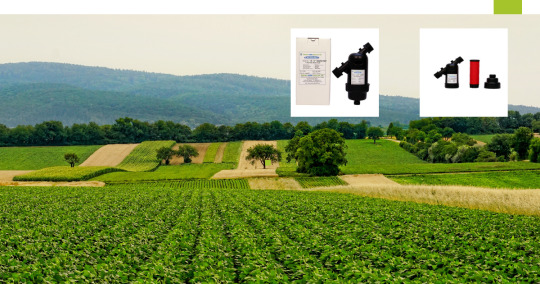
Selecting the right water filter for your farm involves considering factors like the type of irrigation system you use, your water source, and your crops' specific needs. The best filter will ensure smooth system operation without blockages and provide your crops with the clean water they need.
1. Understanding Your Water Source for Optimal Filtration
Knowing your water source is essential in choosing the correct filter, as different sources have varying impurities:
Surface Water (Lakes, Rivers, Canals): Often contains organic debris, algae, and sediments. Disc filters and gravel filters are ideal for handling these impurities.
Groundwater (Wells): Typically contains sand and fine particles. Screen filters and disc filters are effective in removing these contaminants.
Recycled Water: May contain microorganisms and chemical pollutants, requiring a combination of filtration and disinfection systems.
2. Matching Filters to Your Crop Type and Irrigation System
Your choice of filter also depends on your crops and the irrigation system you use:
Drip Irrigation Systems: Prone to clogging, so using disc filters or screen filters is crucial to prevent debris from blocking the system.
Sprinkler Systems: Require clean water; a combination of gravel and disc filters ensures no large particles enter the system.
Micro-Irrigation: Needs high-efficiency filters like the 2-inch PP Disc Filter or 90mm Disc Filter to handle small particles that could clog narrow tubes.
3. Choosing the Best Filtration Type for Your Farm’s Needs
Different types of filters have unique benefits. Here’s a breakdown of the most common types used in agriculture:
Disc Filters: Use grooved discs to trap particles and are effective for filtering organic and inorganic materials. Popular options include the 2-inch PP Disc Filter and the 90mm Disc Filter.
Screen Filters: Use a mesh screen to catch debris. They are easy to clean and ideal for farms using groundwater with minimal debris.
Gravel Filters: Suitable for large-scale operations dealing with heavy debris and sediments. Robust and can handle high-flow systems.
Combination Filters: Some farms may need a mix of disc, screen, and gravel filters for optimal performance, especially with multiple water sources.
Top Water Filters from Leading Manufacturers in Gujarat
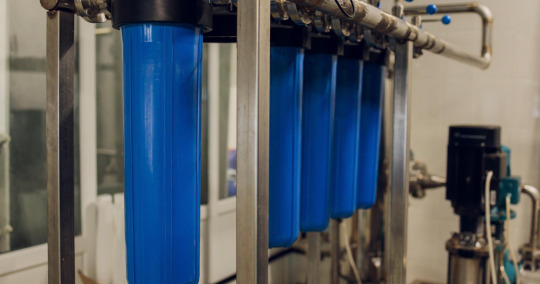
To assist you in making an informed choice, here are some top water filter products that are effective for agriculture in Gujarat:
1. 2 Inch PP Disc Filter: Ideal for Small to Medium Farms
Best for drip or micro-irrigation systems.
Traps fine particles efficiently and can handle high water flow without clogging.
A top choice among Gujarat’s water filter manufacturers due to its durability and effectiveness.
2. 90mm Disc Filter: Perfect for High Flow Irrigation Systems
Suitable for large irrigation systems with high water flow requirements.
Its 90mm size allows it to handle larger water volumes, making it ideal for extensive farming needs.
A popular option among irrigation filter suppliers in Gujarat.
3. PP Screen Filter: Best for Groundwater Filtration
Ideal for farmers using groundwater or well water.
Easy to clean and maintain, effectively removing sand and small particles.
4. Gravel Filters with BW Assembly: For Heavy Debris Management
A robust solution for water sources with significant sediment or debris.
Built to withstand the demands of large-scale farming operations.
5. Drip Irrigation Filters: Specialized for Gujarat’s Irrigation Needs
Designed to handle small particles that can clog drip irrigation systems.
Choose filters tailored to your water source and crop needs for the best results.
Benefits of Choosing a Local Water Filter Supplier in Gujarat
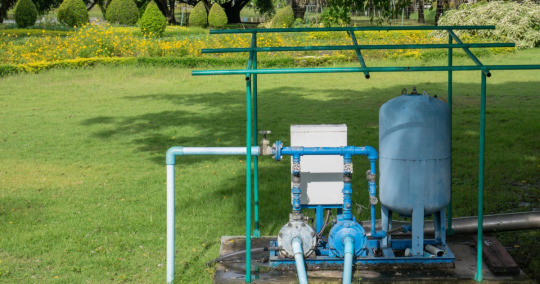
1. Tailored Solutions for Gujarat’s Unique Water Challenges
Local manufacturers understand the region’s specific water challenges, including quality and sediment levels.
They can provide filtration solutions designed for Gujarat’s unique agricultural needs.
2. Quick Access to Products and Support from Local Experts
A local water filter supplier in Gujarat offers faster access to products, parts, and maintenance support, ensuring minimal irrigation system disruptions.
3. Custom Filtration Solutions for Gujarat's Agricultural Sector
Local suppliers can offer customized filtration systems tailored to your farm’s specific needs, ensuring optimal performance and crop health.
Conclusion: Partner with the Right Water Filter Manufacturers in Gujarat
Water is not just a resource in agriculture; it’s the foundation of your farm’s productivity. Investing in the right water filter is essential for maintaining the health of your crops and ensuring efficient water usage.
Whether you need a 2-inch PP Disc Filter, a 90mm Disc Filter, or a more robust solution like Gravel Filters with BW Assembly, partnering with a reputable water filter manufacturers company in Gujarat ensures you have the best filtration technology for your agricultural needs.For those utilizing drip irrigation, understanding the Benefits of Drip Irrigation Systems highlights the importance of having clean, debris-free water. This ensures that your irrigation system operates efficiently, maximizing crop growth and minimizing maintenance issues. With the right filtration system in place, you can focus on what matters most—growing healthy, productive crops and ensuring the long-term success of your farm.
0 notes
Video
youtube
DFShou filters
This Y-type irrigation filter shell is made of high-quality composite plastic, which is pressure-resistant, impact-resistant, and durable. The filter core is available in stainless steel screen and disc to suit different needs.
Easy to install and operate. Contact us today for a variety of irrigation system and filers need.
0 notes
Note
Thinking about ostomy whump, so I have one question. How would a character care for their ostomy? How would they receive the ostomy surgically? What does the recovery look like? How long is recovery? How would they be treated before discharge?
Thinking more like the permanent ostomy, but I also know they have it for more temporary purposes.
If you can, I also want to see actual websites that talk and actually support people with ostomies. It's okay if you cannot answer, this is terribly obscure for a whump topic.
Thank you!
You're in luck! Ostomy care is one of the topics that gets drilled in nursing school and I've had to study it three times for different exams!
There are several types of intestinal ostomies. Ileostomies lead out from the ileum and colostomies lead out from some part of the colon (large intestine), including the ascending, transverse, descending, or sigmoid portions. The diagram below shows these locations.
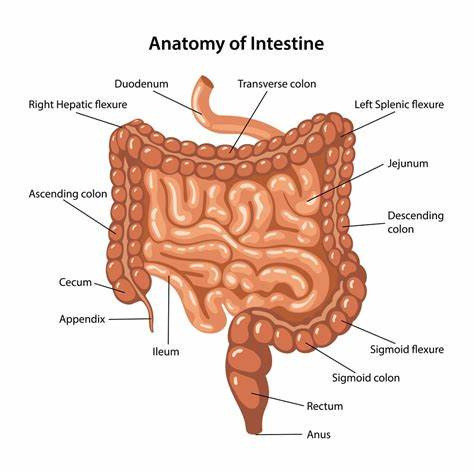
Temporary ostomies can be created to allow a portion of bowel to heal or until two portions of bowel can be connected. A permanent ostomy is created when a large portion of bowel has to be removed, such as for cancer, diverticulitis, inflammatory bowel disease, or severe trauma.
Bowel resection and ostomy creation is done under general anesthesia. The surgery removes the diseased or dead portion of bowel and creates a hole in the abdominal wall, which the healthy end of the bowel in pulled through and folded back on itself. The ostomy should be roughly donut-shaped and red or pink. The postop recovery will be the same as for any abdominal surgery (described in this post), but the patient will be taught to care for their ostomy before they are discharged. If the surgery was open, the patient may be in the hospital for up to a week and be fully recovered in about 6 weeks. If the surgery was laparoscopic, the patient will likely be discharged after 1 or 2 days and will be fully recovered in about 2 weeks. The ostomy will start to function 2 to 3 days after the surgery.
As soon as possible, the patient will be encouraged to learn how to change their own ostomy bag. A nurse will perform the first change while teaching that patient and, if they are comfortable, the patient will perform subsequent changes. This may take some time, since many patients struggle with the change in body image and are reluctant to touch or even look at the ostomy at first. The patient will not be forced to change the bag if they are uncomfortable. This is a washable and reusable ostomy bag:
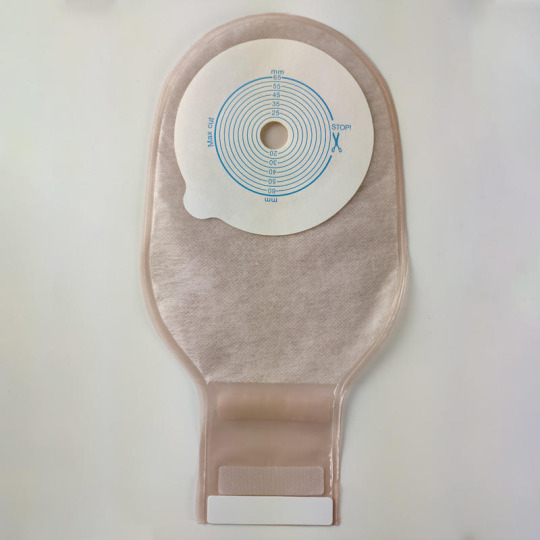
The adhesive wafer should be cut to 1/8-1/16th centimeter larger than the ostomy. When the bag is applied, the wafer is applied to the peristomal skin. Any hair should be clipped and the skin should be washed with soap and water before application. The bag is then attached to the wafer. The clip at the bottom can be removed to empty the bag. Some bags have deodorizing filters that release collected gas.
The patient should assess their stoma weekly for narrowing, protrusion, or retraction. Dull, blue, or black coloring of the stoma or new onset swelling may indicate complications and should be reported to the patient's doctor or nurse. Reddened or broken peristomal skin should also be reported.
The character of the stoma output depends on the location of the ostomy. Ileostomy output will be liquid, while sigmoid colostomy output will resemble typical fecal matter, and so on. The bag should be changed when it is 1/3 to 1/2 full. Intestinal gas will also flow into the bag, which is often a concern for patients due to odor and inflation of the bag. Deodorizing filters are available, or the patient can place a breath mint in the bag to eliminate odor. For lower colostomies, irrigation may be required to regulate bowel movements. This is performed in a similar manner to an enema, by hanging a bag of tap water and directing the tube into the ostomy.
Diet does not require much adjustment after an ostomy, but patients may want to limit fiber to reduce gas. However, the patient should still eat fiber and drink plenty of fluids to prevent constipation. Stool softeners may also be taken. No foods are forbidden, but foods with lots of insoluble fiber like popcorn may cause discomfort.
Many times, people with new ostomies are connected with a trained volunteer who also has an ostomy ("ostomate"). Patients can be referred to the United Ostomy Associations of America or the Wound, Ostomy, and Continence Nurses Society (which provides educational resources and connects patients with nurses that specialize in ostomies).
Happy whumping!
6 notes
·
View notes
Text
Base project - progess 2023
This one's been long overdue, huh? I haven't really been able to keep consistently updating this project, school's been hectic the past few months. ANYWAY:
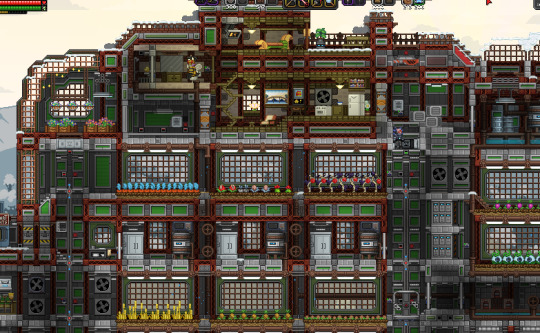
The greenhouse is now complete! I finished it off with a small apartment for the resident gardener, currently dressed like a bee and sitting on their porcelain throne.
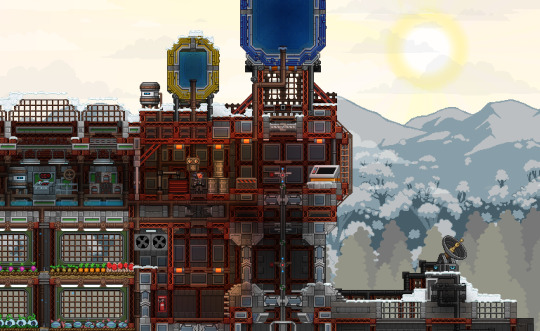
To the east of the gardener's apartment are more water facilities. Three water tanks for irrigation and a control centre for the sprinklers.
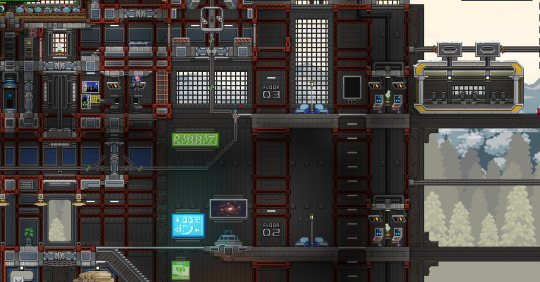
Public transportation! The subway/tram/metro/whatever-station is almost complete. I really loved getting to use these big, glowing hylotl signs.

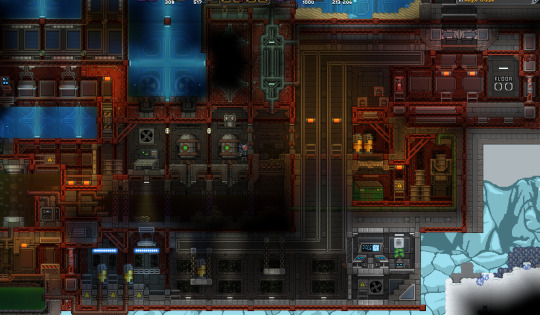
SEWERS!!!!!! YAYY!!!!!!!!! Don't really know why, but this part of the base has been really fun to build? I defo enjoy putting together the areas "behind the scenes" of the build, those areas that keep the whole thing operating smoothly. So waste water comes through the pipe section in the middle of the second screenshot, and trash and other waste clumps are filtered out, and sealed within barrels, which you can see to the right.
The waste water continues into this piece of machinery with the two station engine thingies, where clean water is pumped into a tank, and everything else is turned into poison and pumped downwards, into a tasteful tank of toxicity. This poison is then put into canisters and transported up to the public transportation station, where it is carried away to a laboratory, or something.
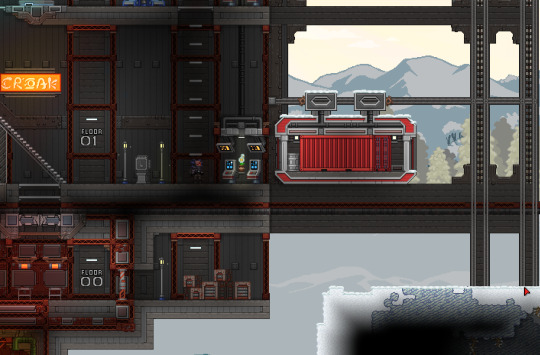
Floor 01 and 00 of the station. A cargo transport is just about to leave!
Well, there it all is, in its yet-to-be-finished-completely-glory. Building on snowy planets has always been something I enjoy, with its aesthetics and pretty scenery. But the Starbound snowing-system is very janky, and sometimes... snow spawns in the lava tank? Like, what?
Apart from that, this is already my largest project in Starbound to date. Can't wait to continue it in 2024!
#starbound#starbound build#can't wait to begin building the botanical gardens#and.... my mansion.... hahahhahahah!!!!
11 notes
·
View notes
Text
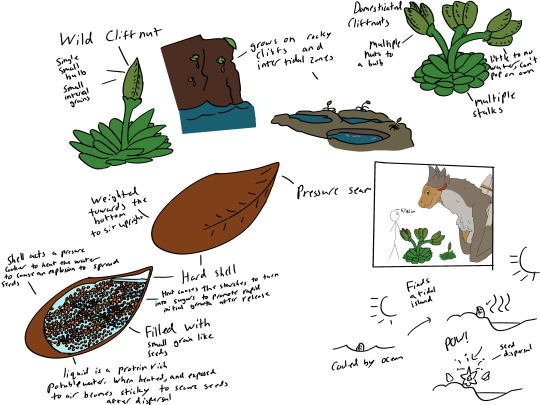
The wild Cliff Nut grows rocky ocean cliffs, intertidal zones, and beaches. It can grow on normal soil but is usually out competed by other plants. Its leaves are similar to succulents. They store filtered fresh water due to the rock they root in being unable to hold onto moisture. While the Cliff Nut can deal with some of the salt from the seawater it uses to survive, anything it cannot naturally process, will be sequestered in the least efficient leaves at the base of the plant which will die off and the salt disposed of. The seedpod of the Cliff Nut has an interesting evolutionary tactic of seed dispersal. Due to the extreme tides of the planet, there are large regions of tidal or shallow beaches that are exposed to the air for a majority of the day. These are picked up by, or are dropping into the water to float along the currents to new land. During its journey, the heavy bottom of the shell keeps a large portion of the nut submerged and cooled by the ocean water. Once it has been deposited by the tide, lack of cooling water begins heating the protein rich interior water of the nut. This causes the fatty proteins in the grain to become simple sugars and the interior water to evaporate. The proteins in the water begin to thicken. These proteins, once exposed to air, will become a sticky, mucous like material that will bind seeds to their new rooting spots. Over the course of about an hour, pressure builds enough to cause an explosion along the pressure seam of the nut, scattering globs of seeds and rooting mucous across wherever the nut has landed. Some land high enough to attach to cliffs which is the safest spot for them to land as they are away from any sea or land based herbivores.
The Wyvara began harvesting these plants for both water and food while their livestock fed on inedible vegetation. Wyvara eventually figured out that instead of allowing these seeds to ferment and explode, they could empty the contents of the nuts into cooking vessels to heat and create a seed paste to smear on cliff faces to grow an exclusive food source as the cliffsides were very inaccessible to most of the threats to the Cliff Nut. The Cliff Nut did not need tending as the ocean waves irrigated the plants without any need for watering. This allowed for a stable, reliable source of food for their next visit on to the island while on their migration circuit. This technique was further refined by hollowing out parts of cliffs into terrace-esque farms. These plant beds were augmented to promote growth by dumping dung of livestock animals fostering a trade between any permanent residents and nomads. The nomads gave fertilizer, meat, and animal products in exchange for tools, food, and grazing rights. The soil is regularly dumped into the sea and replaced to prevent toxic salt buildup and to renew soil nutrients.
From the artificially improved growing conditions and Wyvara influence selection, the Cliff Nut began to grow larger. More stalks for nuts and more nuts per stalk. Several different strains of Cliff Nut are in use today. The glue producing Cliff Nut has very low amount of internal grain and a much higher concentration of congealing proteins in the internal water. They are a renewable source of adhesives for settled communities. Grain Cliff Nuts are bred for the maximum amount of grain. They cannot naturally explode and must be manually opened by Wyvara to disperse seeds due to there being almost no water in their nuts. Salt Cliff Nuts are bred for their salt-sacrifice leaves. They are used in a large amount of Wyvara traditional dishes and barely produce any nuts and when they do they are rather small. They absorb an extreme amount of salt and push it in very high concentrations into leaves. Fig(2) is a late Clan era farm where permanent residents were becoming largely self sufficient and experts at farming. Slowly beginning to domesticate the Cliff Nut into a proper staple food crop.
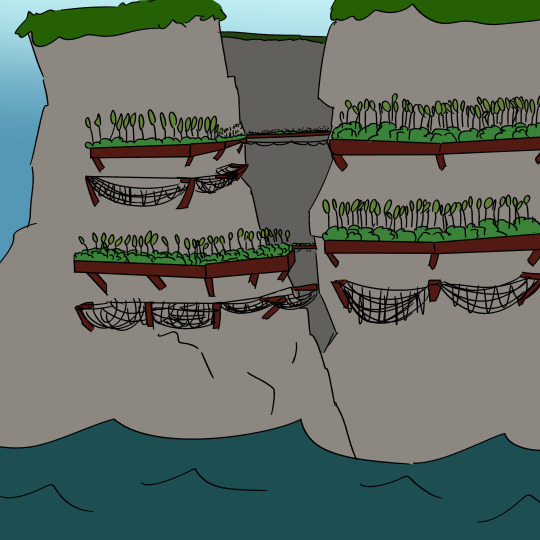
Nets are often used to ensure minor crop loss from any premature dropping or rogue waves stealing crops. They are also regularly scraped for surplus salt.
3 notes
·
View notes
Text
Top 10 Essential Gardening Tips for Adult Beginners: A Comprehensive Guide

Welcome to the delightful world of gardening, where the symphony of nature and the thrill of nurturing your own green haven awaits. If you're a gardening novice, fear not! This guide is tailored just for you. Whether you're cultivating a windowsill herb garden or transforming your backyard into a botanical paradise, these tips will set you on the path to success.
Start Small, Dream Big: As a beginner, resist the temptation to turn your entire yard into a lush Eden. Begin with a small plot or even containers for your favorite plants. This allows you to learn the basics without feeling overwhelmed.
Know Your Zone: Familiarize yourself with your USDA hardiness zone. This information is crucial for selecting plants that will thrive in your specific climate. Understanding your zone helps you make informed choices and increases the likelihood of a flourishing garden.
Sunshine and Shade: Different plants have different light requirements. Pay attention to the sunlight patterns in your garden and choose plants accordingly. Sun-loving plants like tomatoes and peppers need at least 6-8 hours of direct sunlight, while shade-loving varieties such as hostas and ferns thrive in filtered or dappled sunlight.
Soil: The Foundation of Success: Healthy soil is the secret behind a thriving garden. Invest in quality soil that suits your plant's needs. Most plants prefer well-draining soil, so be sure to amend your soil with compost to enhance its structure and fertility.
Water Wisely: The age-old adage "more is not always better" holds true for watering. Overwatering can be as harmful as underwatering. Research the water requirements of your plants, and water consistently. Consider using a drip irrigation system for efficient and controlled watering.
Choose the Right Tools: Equip yourself with the essential gardening tools. A durable pair of gloves, a trowel, pruners, and a watering can are must-haves. Quality tools not only make gardening more enjoyable but also contribute to better results.
Companion Planting: Take advantage of companion planting to maximize space and enhance growth. Some plants complement each other, deterring pests or providing mutual support. For example, planting basil near tomatoes can improve tomato flavor and protect against certain pests.
Pest Management: Be vigilant about pests, as they can quickly wreak havoc on your garden. Familiarize yourself with common garden pests in your area and adopt natural pest control methods, such as introducing beneficial insects or using neem oil.
Embrace Trial and Error: Gardening is a journey of discovery. Not every plant will thrive, and that's okay. Learn from your experiences, celebrate successes, and view challenges as opportunities for growth. Remember, every gardener, no matter how seasoned, has faced setbacks.
Celebrate the Seasons: Gardening is a dynamic, seasonal activity. Embrace the ebb and flow of the gardening calendar. Plan your garden to ensure a continuous display of colors and harvest throughout the seasons. Consider incorporating flowering plants for beauty and pollinator support.
In conclusion, embarking on your gardening journey as an adult beginner is an exciting adventure filled with growth and fulfillment. By starting small, understanding your environment, and adopting these tips, you'll soon find yourself immersed in the joys of cultivating a thriving garden. Happy gardening!
#botany#garden#gardening#horticulture#how to#life hacks#planting#plants#tips and tricks#gardening for beginners#seed starting#mulching#harvesting vegetables#composting#vegetables#vegetable gardening#container gardening#gardening tips#seeds#vegetable#fertilizing vegetables
5 notes
·
View notes
Text










For my afternoon session I did the Studio and Lightning workshop. Here I learnt how to use all the different lighting equipment and also how to use thr cameras. We were shown different ways we could take photos and how to use different materials and items to make our own filters. We also got to use the dark room to create various different lightings and effects. At this point i had decide to focus on water for my brief. How disrupting water creates different effects and how these disruption cause waves or tides. I'll also be looking at how us people disrupt water with dams and bridges to irrigation systems.
13 notes
·
View notes